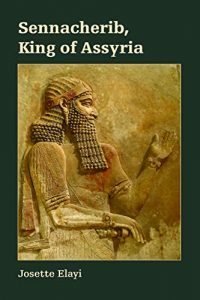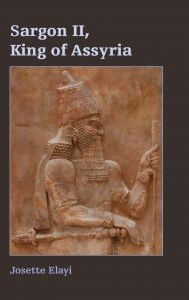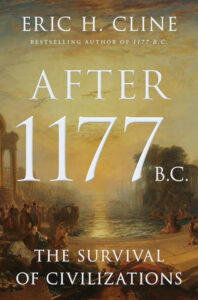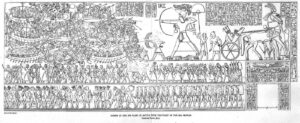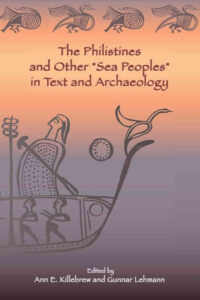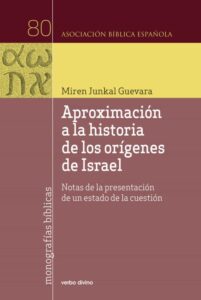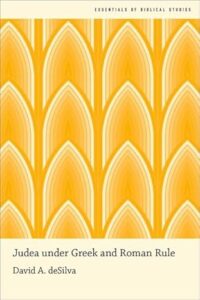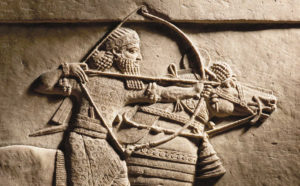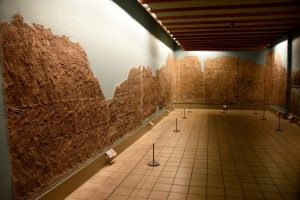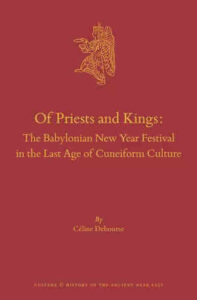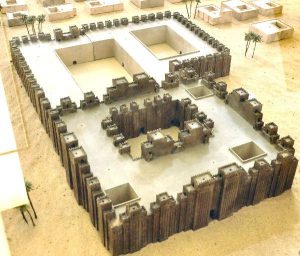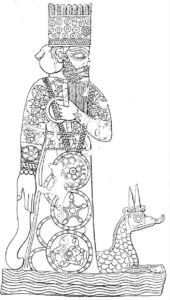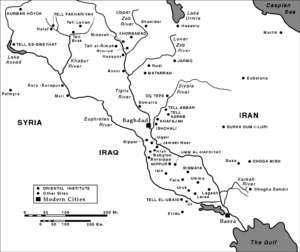ELAYI, J. Sennacherib, King of Assyria. Atlanta: SBL, 2018, 256 p. – ISBN 9780884143178.
O capítulo 6 do livro de Josette Elayi sobre Senaquerib, rei da Assíria é End of Reign (688-681). A autora trata da situação da cidade de Babilônia após sua destruição por Senaquerib em 689 a.C., da nomeação do príncipe herdeiro e dos problemas da sucessão e, finalmente, do assassinato de Senaquerib em 681 a.C.
Abaixo, trechos do capítulo 6, p. 133-152, especialmente os itens 2 e 3, sobre o problema da sucessão [6.2. Problem of Succession] e sobre o assassinato de Senaquerib [6.3. Sennacherib’s Murder].
As 104 notas de rodapé do capitulo foram omitidas, mas podem ser consultadas na obra, disponível para download gratuito no Projeto ICI da SBL. Há uma bibliografia selecionada no final do texto. Acrescentei ao texto alguns subtítulos e remodelei os parágrafos para facilitar a leitura.
As fontes sobre o período – The Royal Inscriptions of the Neo-Assyrian Period – podem ser consultadas em Oracc.
O período entre a destruição da Babilônia em 689 e a morte de Senaquerib em 681 é pouco conhecido. Há pouquíssimos textos e, em particular, nenhuma informação nas inscrições reais sobre a política externa assíria. Foi provavelmente um período de relativa paz, Pax Assyriaca, embora alguns problemas possam ter ocorrido (…) Em 688, Senaquerib tinha pouco menos de sessenta anos e provavelmente estava cansado após quinze anos de campanhas militares com poucas pausas. Como todos os seus objetivos haviam sido alcançados, sem dúvida ele queria descansar e se dedicar inteiramente às atividades que mais lhe interessavam, como construir e inovar, como mostram suas inscrições.
(…)
Nesse período de relativa paz, Senaquerib tinha uma grande preocupação: o problema de sua sucessão. Seu pai, Sargão, havia resolvido corretamente esse problema ao designá-lo príncipe herdeiro logo no início de seu reinado.
1. Ashur-nâdin-shumi, príncipe herdeiro
Senaquerib parece ter designado vários de seus filhos, sucessivamente, como príncipes herdeiros. Não está totalmente claro quem foi o primeiro. Logicamente, seu filho mais velho, Ashur-nâdin-shumi, que havia recebido uma casa em Assur de seu pai, deveria ter sido designado príncipe herdeiro. No entanto, em 700, Senaquerib o instalou como rei da Babilônia, e seu governo durou seis anos, até sua captura e deportação para o Elam em 694. Portanto, ele provavelmente não poderia ser rei da Babilônia e príncipe herdeiro da Assíria ao mesmo tempo.
(…)
2. 698: Urdu-Mullissu, príncipe herdeiro
A necessidade de resolver a questão da sucessão deve ter se tornado urgente para Senaquerib, que provavelmente fez um acordo permanente após 700.
O título mār šarri significava literalmente “filho do rei”, ou “príncipe” em geral, e também “príncipe herdeiro”. Este segundo significado era sempre o de cartas, relatórios e textos administrativos contemporâneos, enquanto os outros filhos do rei eram regularmente referidos apenas pelo nome.
Theodore Kwasman e Simo Parpola examinaram até que ponto esse uso também se aplicava a textos jurídicos. Após demonstrarem que se aplicava a textos datados dos reinados de Asaradon e Assurbanípal, eles examinaram seis textos datados de 683 a 681.
O texto 103 pertencia ao arquivo de Aplaya. Ele era o “terceiro homem” (isto é, o escudeiro de uma carruagem) de “Urdu-Mullissu, o príncipe herdeiro”. Urdu-Mullissu era o “segundo filho” (māru tardennu) de Senaquerib. Ele havia recebido uma casa de seu pai, que foi descoberta nas escavações. Ela estava situada na muralha oriental de Assur e estava em construção por volta de 700. Vários objetos religiosos foram encontrados em seu interior, juntamente com algumas inscrições, indicando que o príncipe tinha alguma função sacerdotal no templo de Assur. Um vaso de pedra com inscrição, dado a ele por Senaquerib, parece indicar que ele viveu em Assur, mas também passou algum tempo na corte real de Nínive. O texto 103 é datado da eponímia de Ilu-isseʾa, ou seja, 694, no décimo segundo dia de Tashrîtu (outubro).
O documento mais antigo do arquivo Aplaya, texto 100, referente a uma grande compra de imóveis, é datado do décimo dia de Simânu (junho) da eponímia de Shulmu-sharri, ou seja, 698. Se o nome de Urdu-Mullissu puder ser restaurado em uma lacuna, isso significaria que ele já era príncipe herdeiro naquela época, o que teria sido uma decisão lógica da parte de Senaquerib após a instalação de Ashur-nâdin-shumi como rei da Babilônia.
Dois outros textos, o número 130, datado de 696, e o número 85, datado do nono dia de Tebêtu (janeiro) de 692, mencionando o título mār šarri, também poderiam se referir a Urdu-Mullissu. O fato de Urdu-Mullissu ter feito um juramento de fidelidade a Asaradon, o novo príncipe herdeiro, não significa que ele não era o príncipe herdeiro anterior, mas que ele não tinha outra escolha a não ser fazer o juramento. Além disso, é bastante improvável que Senaquerib não tenha designado um príncipe herdeiro antes de 683, após vinte e um anos de reinado.
No entanto, quatro outros textos referentes aos condutores de carros reais, datados de 694 a 693, levantam uma dificuldade. Três deles (números 37, 39 e 40) mencionam “Samaʾ, criador de cavalos do mār šarri” como testemunha da transação, enquanto o texto 41 menciona “Samaʾ, criador de cavalos de Nergal-shumu-[…]”. É importante notar que o texto 37 (1 de outubro de 694) é praticamente contemporâneo do texto 103 (12 de outubro de 694), referindo-se a Urdu-Mullissu, o príncipe herdeiro.
Como Samaʾ foi mencionado alternadamente como “criador de cavalos do príncipe herdeiro” e “de Nergal-shumu-[ibni]” em 694 e 693, isso poderia significar que Nergal-shumu-ibni era então príncipe herdeiro da Babilônia (?), em paralelo com Urdu-Mullissu, príncipe herdeiro da Assíria, em vista do paralelo posterior de Assurbanípal e Shamash-shumu-ukîn.
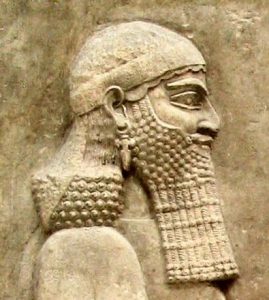 Assim, Urdu-Mullissu foi provavelmente nomeado príncipe herdeiro da Assíria pelo menos a partir de 698.
Assim, Urdu-Mullissu foi provavelmente nomeado príncipe herdeiro da Assíria pelo menos a partir de 698.
É preciso confirmar se Nergal-shumu-ibni foi nomeado príncipe herdeiro da Babilônia em 693.
Mesmo que não tenhamos informações sobre o(s) príncipe(s) herdeiro(s) durante os anos seguintes, isso nos leva a supor que não houve mudança.
3. 683: Asaradon, príncipe herdeiro
Então, quando Asaradon, por sua vez, tornou-se príncipe herdeiro?
Dois textos posteriores dizem respeito a Seʾmadi, administrador da aldeia do príncipe herdeiro: o texto 109, datado de 683, e o texto 110, datado do dia dezesseis de Addaru (março) de 681, apenas doze (ou dois) dias antes da ascensão de Asaradon. O texto seguinte de Seʾmadi, número 111, datado de Tashrîtu (outubro) de 680, não menciona mais seu título de administrador da aldeia do príncipe herdeiro.
Esses textos foram interpretados da seguinte forma: o príncipe herdeiro mencionado nos dois textos datados de 683 e 681 era Asaradon, e seu título desapareceu do terceiro texto porque ele havia se tornado rei da Assíria.
Sugere-se que a nomeação de Asaradon ocorreu em Nisanu (abril) de 683 ou em 682. De acordo com os textos legais precedentes, é possível propor 683 como a data mais provável para a nomeação de Asaradon como príncipe herdeiro da Assíria, possivelmente no mês de Nisanu (abril), durante o Festival de Ano Novo no templo de Akîtu, em Assur.
No vigésimo segundo ano de Senaquerib (683), ele dedicou pessoal ao recém-construído templo de Akîtu, possivelmente em relação à nomeação de Asaradon.
Esta nomeação também pode estar relacionada com um presente dado por Senaquerib ao seu filho, pulseiras de ouro, uma coroa e colar de ouro e anéis para o braço: “Eu dei a Asaradon, meu filho, que doravante será chamado Ashur-etellu-ilâni-mukîn-apli, como um símbolo de amor. (Do) saque de Bît-Amukâni.” A inscrição não tem data, mas afirma-se que seu nome será alterado para Ashur-etellu-ilâni-mukîn-apli, “Assur, príncipe dos deuses, está estabelecendo um herdeiro”, o que significa que a doação foi feita na época de sua promoção a príncipe herdeiro. O saque de Bît-Amukâni refere-se a uma das campanhas de Senaquerib na Babilônia, a última em 689. No entanto, não há indicação da data da doação.
Uma pequena cabeça de leão de pedra de Sipar ou Nínive, dada por Senaquerib a Asaradon, também não tem data: em uma passagem danificada, ele é chamado de DUMU-šú GAL?, traduzido como “seu filho de posição sênior”, o que significaria que a doação foi oferecida após sua nomeação oficial como herdeiro designado.
Como pode ser explicada a nomeação de Asaradon como príncipe herdeiro?
Esta escolha não era óbvia, primeiro porque ele era o filho mais novo de Senaquerib e, segundo, porque ele tinha uma doença debilitante crônica, que acabou por matá-lo e que já era visível quando ele era príncipe herdeiro.
O próprio Asaradon explica a escolha de seu pai: “Sou o irmão mais novo de meus irmãos mais velhos (e) por ordem dos deuses Assur, Sîn, Shamash, Bêl e Nabû, Ishtar de Nínive e Ishtar de Arbela, (meu) pai, que me gerou, elevou-me firmemente na assembleia de meus irmãos, dizendo: ‘Este é o filho que me sucederá’. Ele questionou os deuses Shamash e Adad por adivinhação, e eles responderam com um firme ‘sim’, dizendo: ‘Ele é o seu substituto’.
Além dessa explicação religiosa, qual foi o verdadeiro motivo da escolha de Senaquerib?
A maioria dos autores considera que Naqiʾa/Zakûtu, uma de suas esposas, tinha tanta influência sobre ele que o convenceu a realizar esse ato sem precedentes.
No entanto, embora seu importante papel seja documentado durante os reinados de seu filho Asaradon e de seu neto Assurbanípal, faltam evidências para o reinado de Senaquerib. Por isso, há autores que discordam de que Naqiʾa tenha sido inteiramente responsável pela escolha de Senaquerib. Ela provavelmente apoiou a ascensão de seu filho, mas não estava representando um menor porque, em 683, Asaradon tinha cerca de trinta anos. Portanto, Naqiʾa provavelmente desempenhou um papel na decisão de Senaquerib, mas Asaradon provavelmente também o fez, o que significa que foi uma combinação de fatores que explicou a decisão do rei (…).
Asaradon parece ter tido uma dimensão “messiânica”: ele era considerado o herdeiro legítimo pelos profetas; ele havia sido criado por sua mãe divina, a deusa Mullissu. Além disso, ele tinha uma mãe humana, cujo nome Naqiʾa (“pura”, “inocente”) lembra a própria deusa sagrada: aos olhos dos profetas, ele era o rei assírio escolhido pelos deuses para derrotar as forças do mal, restaurar a ordem e salvar o país.
4. O conflito interno
A decisão de Senaquerib causou grande conflito interno. O mais fortemente atingido foi provavelmente Urdu-Mullissu, o segundo filho mais velho, especialmente se ele já tivesse sido príncipe herdeiro por cerca de quinze anos.
Senaquerib devia estar ciente dos problemas que sua decisão provocaria e decidiu contê-los impondo um juramento de lealdade.
Este tratado de sucessão foi encontrado nas escavações de Assur, mas seu estado é fragmentário, e é impossível dizer o quanto falta. O nome de Senaquerib é preservado, mas o nome de Asaradon está faltando: “Você protegerá [Asaradon, o príncipe herdeiro designado, e] os outros príncipes [que Senaquerib, rei da Assíria, apresentou] a você.”
Este tratado é mencionado nas inscrições de Asaradon: “Diante dos deuses Assur, Sîn, Shamash, Nabû, (e) Marduk, os deuses da Assíria, os deuses que vivem no céu e no mundo inferior, ele (Senaquerib) os fez jurar seu(s) juramento(s) solene(s) sobre a salvaguarda da minha sucessão”.
Sem dúvida, todos, incluindo Urdu-Mullissu e seus irmãos, foram obrigados a prestar juramento.
Este tratado de sucessão foi seguido pela admissão de Asaradon na casa de sucessão: “Em um mês favorável, em um dia propício, de acordo com seu comando sublime, entrei alegremente na casa de sucessão, um lugar inspirador onde a nomeação para a realeza (ocorre).”
Aparentemente, Senaquerib sentiu que poderia controlar a situação, porque não afastou seus outros filhos de Nínive. Eles permaneceram na corte de Nínive, em contato próximo com Asaradon, e lhe causaram problemas conspirando pelas suas costas, como ele relata em suas inscrições: “Rumores malignos, calúnias que começaram contra mim, (e) calúnias sobre mim contra a vontade dos deuses, e eles estavam constantemente dizendo mentiras insinceras, coisas hostis pelas minhas costas. Eles afastaram de mim o coração bem-intencionado de meu pai contra a vontade dos deuses, (mas) no fundo ele era compassivo e seus olhos estavam permanentemente fixos em meu exercício da realeza.”
De acordo com Parpola, os rumores espalhados pelos irmãos de Asaradon diziam respeito à sua doença*. A doença do rei não pôde ser mantida em segredo porque era visível e conhecida na corte de Nínive. Além disso, é possível que, durante esse período, Asaradon tenha sofrido um surto de doença que o teria impedido de reinar. De qualquer forma, quando o objetivo é desacreditar alguém, é sempre fácil espalhar todo tipo de calúnias e boatos falsos.
Seus irmãos tentaram desacreditá-lo, em particular perante Senaquerib, a fim de fazê-lo mudar de ideia. Esse período durou da nomeação de Asaradon como príncipe herdeiro e do juramento de lealdade em 683 até sua partida em Nisanu (abril) de 681.
Asaradon resistiu às calúnias de seus irmãos, provavelmente com a ajuda de sua mãe, Naqiʾa. Após um período ideal em que o futuro estava assegurado para ela e seu filho, a oposição à nomeação de Asaradon começou a ganhar força. Sem dúvida, ela se esforçava para neutralizar os relatos negativos sobre Asaradon que chegavam a Senaquerib. Em particular, ela recorreu à extispicidade, à astrologia e aos oráculos para obter sinais favoráveis. Vários oráculos foram consultados por ela e Asaradon devido à gravidade da situação e à necessidade de obter um prognóstico sobre o futuro da realeza. Bêl-ushezib, um conhecido astrólogo babilônico, enviou uma carta a Asaradon, dois meses após sua ascensão, na qual o lembrou do que havia feito para apoiá-lo anteriormente: “Contei o presságio da realeza de meu senhor Asaradon, o príncipe herdeiro, ao exorcista Dadâ e à mãe do rei.”
5. Asaradon foge de Nínive
No início de 681, por volta de Nisanu (abril), a conspiração contra Asaradon pela sucessão tornou-se mais grave, e a situação tornou-se muito perigosa para o príncipe
herdeiro. Ele foi obrigado a fugir de Nínive.
A explicação que está em suas inscrições baseia-se em uma intervenção divina. Depois de refletir sobre o assunto, ele se convenceu de que seus irmãos não poderiam fazer nada contra a vontade dos deuses. Portanto, ele orou ao deus Assur, rei dos deuses, e a Marduk, o deus babilônico tirado da Babilônia, que odiava conversas traiçoeiras. Eles responderam às suas preces e salvaram sua vida para seu futuro reinado: “Por ordem dos grandes deuses, meus senhores, eles me estabeleceram em um lugar secreto (ašar niṣirti), longe das más ações, estenderam sua agradável proteção sobre mim e me mantiveram seguro para (exercer) o reinado.”
Em que condições Asaradon deixou Nínive? Foi um exílio? Teria sido uma medida protetiva tomada por Senaquerib em favor do príncipe herdeiro por motivos de segurança?
Os autores discordam sobre este ponto: Asaradon teria sido exilado ou por estar temporariamente em desfavor ou por estar ele próprio conspirando contra o pai (e, por fim, o teria matado). Essa teoria é improvável, pois Senaquerib não mudou o príncipe herdeiro, que permaneceu Asaradon, como afirma em suas inscrições.
Sua decisão de proteger o príncipe herdeiro, mandando-o embora, parece mais lógica, visto que ele não havia escolhido outro herdeiro. A remoção de Asaradon da corte de Nínive durou aproximadamente nove meses. Onde ele permaneceu durante esse longo período não é revelado nas inscrições de Asaradon. A localização deste lugar tem sido muito debatida: por exemplo, sugere-se que o príncipe herdeiro encontrou um refúgio seguro com a família em Harã.
Enquanto isso, em Nínive, a situação estava tão conturbada que a instituição tradicional do epônimo foi perturbada. Um documento assírio é datado no dia 5 de Ayyaru (maio) da “eponímia após Nabû-sharru-usur”, ou seja, em 681: essa situação de agitação pode ter impedido a nomeação do novo epônimo no momento certo.
O que aconteceu com Naqiʾa durante esse período? Com base na suposição de que ela tinha imensa influência sobre Senaquerib, alguns autores sugeriram que ela exercia um novo poder, por exemplo, como governadora da Babilônia. No entanto, essa teoria não está documentada. Também foi sugerido que Senaquerib lhe deu um novo status, mantendo-a ao seu lado em cerimônias religiosas, no contexto de sua reforma religiosa.
6. O assassinato de Senaquerib
A ausência de Asaradon criou um impasse para seus irmãos. Ele havia sido removido, mas a sucessão permaneceu inalterada, pois Senaquerib persistiu em sua decisão: Asaradon ainda era o príncipe herdeiro e tinha apoiadores em Nínive, em particular entre os profetas e adivinhos que proferiram vários oráculos em seu favor.
Esses apoios provavelmente levaram seus irmãos a agir. Na verdade, eles não conseguiriam nada esperando. Consequentemente, optaram pela ação. Este momento é descrito nas inscrições de Asaradon: “Depois disso, meus irmãos enlouqueceram e fizeram tudo o que desagradava aos deuses e à humanidade, e planejaram o mal, cingiram (suas) armas e, em Nínive, sem os deuses, eles se atracaram como crianças pelo (direito de) exercer a realeza.”
Senaquerib foi morto no dia 20 de Tebêtu (janeiro) de 681. A data é fornecida pelas Crônicas Babilônicas: “No vigésimo dia do mês de Tebêtu, Senaquerib, rei da Assíria, foi morto em uma rebelião. Por [vinte e quatro] anos, Senaquerib governou a Assíria.” O assassinato de Senaquerib é apenas aludido em termos velados nas inscrições de Asaradon: “Os deuses… viram os feitos dos usurpadores que agiram injustamente contra a vontade dos deuses e não os apoiaram.”
No entanto, este evento, que teve um impacto profundo e duradouro sobre o povo do antigo Oriente Médio, é registrado em inúmeras fontes, todas elas posteriores, exceto por uma carta datada de 680, possivelmente para Asaradon, e pelas Crônicas Babilônicas contemporâneas. Pode-se entender que, após a destruição da cidade de Babilônia, os babilônios não ficassem aborrecidos com a morte de Senaquerib.
Onde ele foi morto e como?
De acordo com as inscrições de Assurbanípal, ele foi morto em seu palácio em Nínive, ao lado dos colossos: “O restante do povo, vivo, junto aos colossos, entre os quais haviam abatido Senaquerib, pai do pai que me gerou — naquela época, eu abati aquele povo ali, como oferenda à sua sombra. Seus corpos desmembrados eu ofereci aos cães, porcos, lobos e águias, às aves do céu e aos peixes do abismo.” Essa ação de vingança ocorreu durante sua sexta campanha, contra os rebeldes da Babilônia, cerca de trinta anos após o assassinato de Senaquerib. Não é especificado quem eram essas pessoas responsáveis pelo assassinato do rei da Assíria: os irmãos de Asaradon ou outras pessoas envolvidas na conspiração?
Segundo a Bíblia, o assassinato ocorreu em Nínive: “Senaquerib, rei da Assíria, levantou o acampamento e partiu. Voltou para Nínive e aí permaneceu. Certo dia, estando ele a adorar no templo de Nesroc, seu deus, Adramelec e Sarasar mataram-no à espada e fugiram para a terra de Ararat. Asaradon, seu filho, reinou em seu lugar” (2Rs 19,36-37; Is 37,38). “Quando ele entrou no templo do seu deus, alguns de seus filhos o mataram à espada (2Cr 32,21).
(…)
A questão de quem foi(ram) o(s) assassino(s) de Senaquerib tem sido muito debatida.
Uma primeira consideração de bom senso é que uma conspiração contra um rei, conduzida por seu filho, geralmente não envolve mais de um príncipe, pois, se a conspiração for bem-sucedida, o novo rei seria tentado a matar seu(s) irmão(s), cúmplice(s) e potenciais rivais.
O próprio Asaradon entrou na lista de suspeitos devido ao silêncio de suas inscrições em relação às circunstâncias que levaram ao assassinato de seu pai, porque ele foi quem mais se beneficiou do crime, porque seu banimento por segurança é um fenômeno único, porque a sucessão de Asaradon durou apenas seis semanas e porque ele reverteu completamente a política de seu pai. No entanto, todos esses argumentos não são decisivos, e essa hipótese é infundada se aceitarmos que Asaradon era o príncipe herdeiro: ele não tinha interesse em matar seu pai e, além disso, estava longe de Nínive no momento de seu assassinato.
O nome do assassino não é conhecido em nenhum texto cuneiforme, e os nomes mencionados pela Bíblia e por Beroso foram obviamente corrompidos textualmente. Seguindo uma teoria antiga, esses nomes teriam sido corrupções de Ardi/Arad-Ninlil, filho de Senaquerib, conhecido de um documento legal contemporâneo.
Parpola foi o primeiro autor a identificar o assassino de Senaquerib em uma carta que tratava de uma conspiração contra o rei (…) Um grupo de habitantes da Babilônia ouviu falar da conspiração, e um deles tentou informar Senaquerib sobre ela. Esse informante se conformava a uma lei assíria que permitia aos súditos apelar ao rei como juiz supremo. Portanto, ele solicitou uma audiência com o rei e foi recebido por dois oficiais, Nabû-shuma-ishkun e Sillâ. Ele foi levado diante do suposto rei e disse: “Urdu-Mullissu, seu filho, vai matá-lo!” Infelizmente, os dois oficiais eram membros da conspiração, e o informante foi levado não a Senaquerib, mas ao próprio Urdu-Mullissu. Ele foi morto, e a tentativa de informar o rei sobre a conspiração contra ele foi frustrada.
Parpola reconsiderou os dois nomes mencionados na Bíblia: o nome Adramelec (ʾdrmlk) difere do nome assírio apenas em dois aspectos: a metátese de r e d, e a substituição de š por k no final do nome. O segundo nome bíblico, Sarasar (śrʾṣr), não é um nome, mas ironicamente significava “Deus salve o rei” (šarru-uṣur); uma hipótese especulativa alternativa é que o nome bíblico poderia ser identificado com Nabû-sharru-usur, governador de Marash/Marqasi, epônimo do ano 682 e possivelmente outro dos filhos de Senaquerib (…) Mesmo que não possa ser definitivamente provado, a teoria de Parpola sobre o não envolvimento de Asaradon na morte de seu pai é a mais provável no estado atual da documentação.
Quais foram os motivos do assassinato de Senaquerib? Os motivos variam conforme as fontes.
Quando a notícia do assassinato chegou à Babilônia e a Judá, provavelmente foi percebida como um castigo divino imposto pelos deuses por seus crimes.
De acordo com uma inscrição do rei babilônico Nabônides: “Ele (Senaquerib) planejou o mal; planejou crimes contra o país; não teve misericórdia do povo [da Babilônia]. Com más intenções, avançou sobre a Babilônia, devastou seus santuários; tornou o território irreconhecível; profanou os ritos de culto. Levou o senhor Marduk embora e o trouxe para a cidade de Assur.” Para os babilônios, Senaquerib era o rei selvagem que havia destruído Babilônia e espalhado o caos por toda a terra oito anos antes.
O assassinato de Senaquerib foi recebido pelos judeus da mesma forma que pelos babilônios, porque eles também sofreram muito nas mãos do conquistador assírio, embora vinte anos tivessem se passado entre o fim da campanha militar assíria contra Judá e o assassinato de 681. Os dois eventos são justapostos na Bíblia para criar a impressão de imediatismo e persuadir os leitores de que Iahweh sempre pune as más ações (2Rs 19,36–37). O profeta Isaías responde aos ministros de Ezequias [que foram consultá-lo por ordem do rei]: “Direis a vosso senhor: Assim fala Iahweh: Não tenhas medo das palavras que ouviste, das blasfêmias que os servos do rei da Assíria lançaram contra mim. Vou insuflar-lhe um espírito e, ao ouvir certa notícia, voltará para sua terra e farei com que pereça pela espada em sua terra” (2Rs 19,5-7).
(…)
Agora, quais foram as verdadeiras razões para o assassinato de Senaquerib?
Acima de tudo, é preciso colocá-lo no contexto mais amplo das dinastias do antigo Oriente Médio, por exemplo, na Mesopotâmia, Egito e Pérsia. Tais assassinatos, regicídio e parricídio, foram favorecidos pela ambiguidade das regras de sucessão, pela multiplicação de possíveis herdeiros legítimos, pela rivalidade entre as diferentes esposas e ramos familiares e pelas intrigas envolvendo haréns.
Urdu-Mullissu, o herdeiro legítimo, não aceitou a perspectiva de ser suplantado por Asaradon, o filho mais novo de seu pai. Quaisquer que sejam as outras possíveis razões para a escolha de Senaquerib, a influência de Naqiʾa provavelmente desempenhou um papel, e Asaradon possivelmente tinha, ou fingia ter, as mesmas opiniões políticas de seu pai. De qualquer forma, ele foi inteligente o suficiente para obter o apoio dos círculos religiosos da corte de Nínive. No entanto, havia um acordo geral contra ele: a oposição era liderada pelos outros filhos de Senaquerib, começando por Urdu-Mullissu, o segundo filho mais velho depois de Shamash-shumu-ukîn, seu falecido irmão.
O assassinato de Senaquerib ocorreu no dia 20 de Tebêtu (janeiro) de 681, e Asaradon ascendeu ao trono no dia 18 ou 28 de Addaru (março). Houve um lapso de tempo de mais de seis semanas. Asaradon estava, sem dúvida, em contato próximo com Naqiʾa e seus apoiadores e foi imediatamente informado do que havia ocorrido em Nínive. Primeiro, ele teve que retornar do local onde vivia pelos últimos nove meses e reunir seu exército e apoiadores. A maior parte do tempo foi provavelmente dedicada a esmagar a rebelião. É claramente mencionado nas Crônicas Babilônicas: “A rebelião continuou na Assíria desde o vigésimo dia do mês de Tebêtu até o segundo dia do mês de Addaru.”
Do segundo dia de Addaru, quando a rebelião foi esmagada, até o décimo oitavo ou vigésimo oitavo dia, quando ele ascendeu ao trono, deve ter havido uma boa quantidade de “limpeza” a ser feita em Nínive. A julgar pelo escopo da rebelião, os rebeldes devem ter contado com o apoio de grande parte da sociedade assíria. Provavelmente, juntaram-se a eles não apenas o partido militar da corte e as cidades que lucravam com as guerras imperiais, mas também todo o povo para quem a tradição assíria, em particular a sucessão real, era sagrada.
 Por que Urdu-Mullissu não aproveitou o assassinato para tomar o poder, como planejara desde o início? Provavelmente porque teve que lutar contra seus irmãos, que também eram ambiciosos, e não conseguiu impor sua influência sobre eles.
Por que Urdu-Mullissu não aproveitou o assassinato para tomar o poder, como planejara desde o início? Provavelmente porque teve que lutar contra seus irmãos, que também eram ambiciosos, e não conseguiu impor sua influência sobre eles.
Asaradon derrotou os rebeldes e venceu esta guerra de sucessão. Ele enfatizou o tratado de lealdade estabelecido por seu pai em 683, garantido pelos deuses: “O povo da Assíria, que havia jurado pelo tratado, um juramento vinculado pelos grandes deuses, a meu respeito, veio diante de mim e beijou meus pés.”
No entanto, a oposição foi tão forte que ele foi obrigado a abandonar os objetivos políticos de seu pai. Este poderia ter sido outro motivo para o assassinato de Senaquerib: a maioria da sociedade considerou seus esforços para adaptar a tradição à nova realidade histórica do Império Assírio como uma ofensa aos deuses, um perigo para a ordem existente.
* Como sabemos pela correspondência deixada pelos médicos e exorcistas reais, seus dias eram tomados por crises de febre e tontura, violentos ataques de vômito, diarreia e dores de ouvido dolorosas. Depressão e medo da morte iminente eram constantes em sua vida. Além disso, sua aparência física era afetada pelas marcas de uma erupção cutânea permanente que cobria grande parte de seu corpo, especialmente o rosto. Seja como for, em uma sociedade que via a doença como um castigo divino, um rei constantemente doente não poderia esperar encontrar simpatia e compreensão (RADNER, K. The trials of Esarhaddon: the conspiracy of 670 BC. ISIMU: Revista sobre Oriente Próximo y Egipto en la antigüedad 6 (2003), p. 169).
Bibliografia selecionada do capítulo 6:
Cogan, Mordechai. “Sennacherib and the Angry Gods of Babylon and Israel.” IEJ 59 (2009): 164–82.
Frahm, Eckart. “Perlen von den Rändern der Welt.” Pages 79–99 in Languages and Cultures in Contact: At the Crossroads of Civilizations in the Syro-Mesopotamian Realm. Edited by Karel Van Lerberghe and Gabriela Voet. RAI 42. Leuven: Peeters, 1999.
Frame, Grant. Rulers of Babylonia from the Second Dynasty of Isin to the End of the Assyrian Domination (1157–612 BC). Toronto: University of Toronto Press, 1995.
Leichty, Erle. “Esarhaddon’s Exile: Some Speculative History.” Pages 189–91 in Studies Presented to Robert Biggs. Edited by Martha T. Roth, Walter Farber, and Matthew W. Stolper. AS 27. Chicago: Oriental Institute of the University of Chicago, 2007.
Parpola, Simo. “The Murderer of Sennacherib.” Pages 171–82 in Death in Mesopotamia. Edited by Bendt Alster. RAI 26. Copenhagen: Akademisk, 1980.
Reade, J. E. “Was Sennacherib a Feminist?” Pages 139–45 in La femme dans le Proche-Orient antique. Edited by Jean-Marie Durand. RAI 33. Paris: ERC, 1986.
Tammuz, Oded. “Punishing a Dead Villain: The Biblical Accounts of the Murder of Sennacherib.” BN 157 (2013): 101–5.
Zawadski, Stefan. “Oriental and Greek Tradition about the Death of Sennacherib.” SAAB 4 (1990): 69–72.
